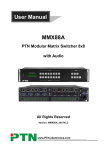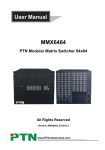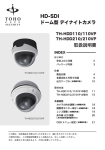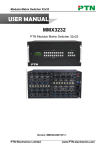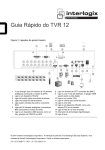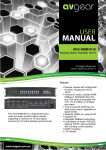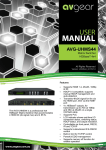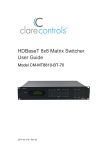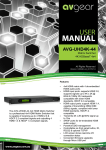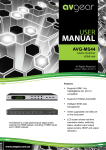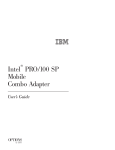Download 16x16 and 32x32 Modular Matrix Switcher User
Transcript
Modular Matrix Switch User Guide Models HDBaseT 16x16 and 32x32 2014-11-753 • Rev 01 Copyright © 06NOV14 Clare Controls, Inc. All rights reserved. This document may not be copied in whole or in part or otherwise reproduced without prior written consent from Clare Controls, Inc., except where specifically permitted under US and international copyright law. Trademarks and patents Modular Matrix Switches, Models CM-MM161610-HD and CM-MM323210-HD name is a trademark of Clare Controls, Inc. Other trade names used in this document may be trademarks or registered trademarks of the manufacturers or vendors of the respective products. Manufacturer Version Contact information Clare Controls, Inc. 7519 Pennsylvania Ave., Suite 104 Sarasota, FL 34243, USA This document applies to HDBaseT 16x16 and 32x32 Matrix Switches Models CM-MM161610-HD and CM-MM323210-HD Rev 01. For contact information, see www.clarecontrols.com. Content Important information...ii Limitation of liability...ii Introduction...1 About the switch system...1 Features...1 Package contents...2 Switcher models...2 Signal cards...2 Front panel...3 Front panel button control...4 External connections...5 Input and output connectors...5 Changeable cards introduction and installation...6 Connecting with the RS-232 communication port...10 Connecting with a computer...10 System diagram...11 IP and RS-232 control protocol...12 Detailed examples...15 Specifications...17 Changeable cards...18 Troubleshooting and maintenance...20 Safety operation guide...21 After-sales service...22 Modular Matrix Switch User Guide i Important information Limitation of liability To the maximum extent permitted by applicable law, in no event will Clare Controls, Inc. be liable for any lost profits or business opportunities, loss of use, business interruption, loss of data, or any other indirect, special, incidental, or consequential damages under any theory of liability, whether based in contract, tort, negligence, product liability, or otherwise. Because some jurisdictions do not allow the exclusion or limitation of liability for consequential or incidental damages the preceding limitation may not apply to you. In any event the total liability of Clare Controls, Inc. shall not exceed the purchase price of the product. The foregoing limitation will apply to the maximum extent permitted by applicable law, regardless of whether Clare Controls, Inc. has been advised of the possibility of such damages and regardless of whether any remedy fails of its essential purpose. Installation in accordance with this manual, applicable codes, and the instructions of the authority having jurisdiction is mandatory. While every precaution has been taken during the preparation of this manual to ensure the accuracy of its contents, Clare Controls, Inc. assumes no responsibility for errors or omissions. ii Modular Matrix Switch User Guide Introduction About the switch system The HDBaseT 16x16 and 32x32 matrix switches are high-performance video and audio modular matrix switches. Various changeable cards make matrix switches flexible and an all-in-one solution for different projects. The matrix switches can support different video signals with cross switching. Every video or audio signal is transmitted and switched independently; this will cause the least signal attenuation, so that the output signal keeps its high fidelity. Two series of changeable cards work with matrix switches, input card MOD-4I series and output card MOD-4O series. All the cards support hot plug-and-play. Users can choose the right card for different applications. Different signal cards are used for processing different video signal, including HMDI, VGA, and HDBaseT. The matrix switches can be used for different projects, because of the changeable card design. It is the combination solution for multimedia conference rooms, control rooms, broadcasting rooms, and shopping centers. The matrix switches can handle all the audio and visual management, including the switching, driving, and scaling. Features • Modular chassis with configurable I/O slots, ranging from 16x16 to 32x32 • Various I/O cards, includes HDMI, VGA, and HDBaseT cards (compatible with YUV, YC and CVBC) to configure any matrix • True cross-point switching for any input to any output, regardless signal format • Advanced EDID management, three ways to guarantee maximum compatibility • Supports HDMI 1.4a and 3D • Integrated HDBaseT technology • I/O cards works directly with CATx or a fiber optic extender • Ultra-switching for an instantaneous display, ensuring the transition runs smoothly • Unique pixel-accurate and re-clocking technology provides exceptional output transmission and accurate timing • Controlled via buttons, RS-232, TCP/IP, IR, also compatible with third-party controls • Field-upgradeable and hot-swappable, friendly to use and maintain • HDCP compliant • LCD display Modular Matrix Switch User Guide 1 Package contents • 1 x modular matrix switch (with empty slots and empty covers) • 1 x RS-232 cable • 1 x IR remote (battery is not included) • 2 x power cord • 4 x plastic cushions • 1 x user manual Switcher models Table 1: Title of the table Model Height Maximum slot Power supplies RS-232 control Network control 16x16 3U 4 input card slots and 4 output card slots Dual √ Optional 32x32 5U 8 input card slots and 8 output card slots Dual √ Optional Signal cards To meet different situation and users, the signal cards are classified into the following models. Input cards Table 2: Input cards Models Inputs Signal Format CM-MOD-HDI10 4 HDMI CM-MOD-VGI10 4 VGA CM-MOD-HDBI10 4 HDBaseT 2 Modular Matrix Switch User Guide Table 3: Output cards Models Outputs Signal Format CM-MOD-HDO10 4 HDMI CM-MOD-VGO10 4 VGA CM-MOD-HDBO10 4 HDBaseT Front panel The 16x16 and 32x32 switches share the same function buttons, but only differ in case height. (1) (2) (3) (4) (5) (6) (1) Power indicator Power 'on' indicator light. (2) IR receiver IR receive window. (3) LCD indicator Shows real-time system status. (4) INPUTS Allows direct selection of the input channel from 1 to 16 or 1 to 32. (5) OUTPUTS Allows direct selection of the output channel from 1 to 16 or 1 to 32. (6) FUNCTION GLOBAL: Used to transfer video and audio signal (HDMI) of an input channel to all output channels. Example: To transfer HDMI signal from input channel 7 to all output channels, press the buttons as follows: Input “0” “7” + “GLOBAL” + “Select”. EDID: Used to manually control EDID management. Example: To learn the EDID data of the display on output channel 2 to input channel 3, press the buttons as follows: "EDID" + Input "0" "3" + Output "0" "2". Modular Matrix Switch User Guide 3 SELECT: Used to transfer video and audio signal (HDMI) from an input to an output. Example To transfer both the video and audio signals from input channel 3 to output channel 4, press the buttons as follows: Input “0” "3" + Output “0” "4" + "SELECT". CLEAR: Clear an operation, such as switching output channel, studying EDID data before it comes into effect. Meanwhile, the switcher returns to the previous state. Front panel button control Users can control the switch rapidly and directly using its front panel buttons. The following is a brief operation guide to operating the front panel buttons. Switching I/O connection Function: Switch I/O connection. It is important to know that input and output channels should be double-digit. For example, input 01 represents input 1. Format: Input Channel + Output Channel + Select Examples • To transfer input 1 to output 11, press the following. (input) 0 1 + (output) 1 2 + Select. • To transfer signals from input 1 to all output channels, press the following. 0 1 + Global + Select. EDID Management Function: Enable the input channel to capture and learn the EDID data of an output. Format: EDID + Input Channel + Output Channel + Select Example • To enable input 1 to learn the EDID data of output 2, press the following. EDID + (input) 0 1 + (output) 0 2 + Select. Clear the previous operation Function: Clears the previous operations before pressing Select to enforce it. Pressing Clear only erases the operations not confirmed by pressing Select. 4 Modular Matrix Switch User Guide Notes • Input Channel: Fill with the number of input channel to be controlled, • Output Channel: Fill with the number of output channels to be controlled. Press Global to select all the outputs. • The input and output channels on the rear panel are counting from left to right, and top to bottom. • The input delay time between two numbers of every input and output channel must be less than 5 seconds; otherwise, the operation will be cancelled. • End every operation by pressing Select to confirm the operation. External connections Input and output connectors The 16x16 switch has 8 card slots (max.) in the rear panel, including 4 input slots and 4 output slots. The 32x32 switch has 16 card slots (max.) in the rear panel, including 8 input slots and 8 output slots. Note: The cards in the pictures are for reference, only. You can choose different cards in different cases, each supporting plug-and-play. Modular Matrix Switch User Guide 5 Changeable cards introduction and installation You can insert changeable cards into empty slots on the matrix switches (hot-swap) and include different signals, such as HDMI, VGA, and HDBaseT. The following introduces you to each card. HDMI cards See Table 10: HDMI (CM-MOD-HDI10 and CM-MOD-HDO10) on page 18. The HDMI signal card is embedded with EDID management technology and supports CEC and DDC. CM-MOD-HDI10: This input card supports four input signals (max.). Input signals can pass to output devices through the MMX-4O-HD, or other types of output cards. CM-MOD-HDO10: This output card supports four output signals (max.). Output signals can come from MMX-4I-HD, or other types of input cards. The following figure shows the pin layout for the HDMI connectors (female). 6 Modular Matrix Switch User Guide Table 4: HDMI connector pin layout Pin Signal Name Pin Signal Name 1 TMDS Data 2+ 20 SHELL 2 TMDS Data 2 Shield 19 Hot Plug Detect 3 TMDS Data 2- 18 +5V Power 4 TMDS Data 1+ 17 Ground 5 TMDS Data 1 Shield 16 DDC Data 6 TMDS Data 1- 15 DDC Clock 7 TMDS Data 0+ 14 No Connect 8 TMDS Data 0 Shield 13 CEC 9 TMDS Data 0- 12 TMDS Clock- 10 TMDS Clock+ 11 TMDS Clock Shield VGA cards See Table 11: VGA (CM-MOD-VGI10 and CMMOD-VGO10) on page 18. Scale all inputs to 1080p. The card is compatible with C-Video, YUV, YC (factory preset function). The bandwidth is up to 350 MHz (-3 dB). It supports RGBHV, RGsB, RGBS, RsGsBs, YUV, YC and Composite video. CM-MOD-VGI10: This input card supports four input signals (max.). Input signal can pass to output device through any kind of output card. CM-MOD-VGO10: This input card supports four output signals (max.). Output signal can pass to output device through any kind of output card. The following figure shows the pin layout for the VGA connectors (female). Modular Matrix Switch User Guide 7 Table 5: VGA connector pin layout Pin Signal Name Pin Signal Name 1 RED 9 KEY/PWR 2 GREEN 10 GND 3 BLUE 11 ID0/RES 4 ID2/RES 12 ID1/SDA 5 GND 13 HSync 6 RED_RTN 14 VSync 7 GREEN_RTN 15 ID3/SCL 8 BLUE_RTN HDBaseT cards Twisted pair card (HDMI extender). See Table 12: HDBaseT (CM-MOD-HDBI10 and CM-MOD-HDBO10) on page 19. The card supports HDTV and is compatible with HDMI 1.4a and HDCP. CM-MOD-HDBI10: This input card supports four HDMI TP input signals. Input signals can pass to the output device through the CM-MOD-HDBO10, or through other types of output cards. Needs to work with the CM-BT10-TX70. CM-MOD-HDBO10: This output card support four HDMI TP output signals (max.). Output signals can come from the CM-MOD-HDBI10, or from other types of input cards. Needs to work with the CM-BT10-RX70. 8 Modular Matrix Switch User Guide Table 6 lists the pin layouts of the RJ45 connectors. You can choose from two different connection standards. The connectors of the same cable should use the same standard. Note: The Cat5e/Cat6 terminations for HDBaseT devices should be a straight thru TIA/EIA T568B standard. TIA/EIA T568A standard is not recommended. Table 6: T568A and T568B cable standards TIA/EIA T568A TIA/EIA T568B Pin Cable color Pin Cable color 1 green white 1 orange white 2 green 2 orange 3 orange white 3 green white 4 blue 4 blue 5 blue white 5 blue white 6 orange 6 green 7 brown white 7 brown white 8 brown 8 brown Note: Cable connectors must be metal, and the shielded layer of cable must be connected to the connector’s metal shell to share the grounding. Modular Matrix Switch User Guide 9 Connecting with the RS-232 communication port You can control the switch from the front panel, IR, or RS-232. The pin definitions are listed in the table below. Table 7: RS-232 connection definitions No. Pin Function 1 N/u Unused 2 Tx Transmit 3 Rx Receive 4 N/u Unused 5 Gnd Ground 6 N/u Unused 7 N/u Unused 8 N/u Unused 9 N/u Unused Connecting with a computer When the MMX matrix connects to the RS-232 port of a computer with control software, users can control it by that computer. To control the switch, users need to use RS-232 control software. 10 Modular Matrix Switch User Guide System diagram The following figure shows a typical system setup. Figure 1: System diagram Modular Matrix Switch User Guide 11 IP and RS-232 control protocol Use this command system to operate and control the matrix switch remotely with RS-232 software. Communication protocol: RS-232 communication protocol Baud rate: 9600 Data bit: 8 Stop bit: 1 Parity bit: none Table 8: RS-232 command types and codes Command Type Command Code Function System Command /*Type Returns the switch model information. /%Lock Lock the front panel buttons on the switch. /%Unlock Unlock the front panel buttons on the switch. /^Version Returns the firmware version installed. /:MessageOff Turn off the feedback command from the COM port. It displays “switch OK”. /:MessageOn Turn on the feedback command from the com port. Demo Puts the switch into Demo mode. Undo Cancels the prior command. All#. Transfer all input signals to the corresponding output channels respectively. All$. Switch off all the output channels. [x]#. Transfer signals from the input channel [x] to the output channel [x]. [x]$. Switch off the output channel [x]. [x1] V[x2]. Transfer the video signals from the input channel [x1] to the output channel [x2]. [x1] B[x2]. Transfer signal from the input channel [x1] to the output channel [x2]. Status[x]. Inquire the input channel to the output channel [x]. Status. Inquire the input channel to the output channels one by one. Save[Y]. Save the present operation to the preset command [Y]. [Y] ranges from 0 to 9. Recall[Y]. Recall the preset command [Y]. Clear[Y]. Clear the preset command [Y]. PWON. Work normally. Operation Command 12 Modular Matrix Switch User Guide PWOFF. Enter Standby mode. All@. Switch on all the outputs. [x]@. Switch on output [x]. HDCPON. Turn on the HDCP output. HDCPOFF. Turn off the HDCP output. HPDNormal Verify the hot-plug of output channels are working normally. HPDBypass Ignore the hot-plug check for the output channels. /V00. Inquire the version of the backboard software. /V1[x]. Inquire the software version of the input signal card [x]. /V2[x]. Inquire the software version of the output signal card [x]. EDIDUpgrade[x]. Upgrade EDID data via the RS232 port [X] is the input port. When the value of X is 5, it means to upgrade to all input ports. When the switch receives the command, it displays a message to send the EDID file (.bin file). Operations will be canceled after ten seconds. UpgradeIntEDID[x]. Upgrade the built-in EDID data. It supports six types of EDID data. When the switch receives the command, it will show a message to send EDID file (.bin file). When X is 1 to 4, it means to upgrade the four built-in EDID data. When X is 5 or 6, it means to upgrade the saved EDID data of the DVI. Operations will be canceled after ten seconds. EDID/[x]/[y]. Set the EDID data of input port [x] to the built-in EDID data of type [y]. The value of [y] is 1, 2, 3, and 4. The EDID data types are same as mentioned above. EDIDG[x]. Get EDID data from the output channel X and display the data on the serial port control software. Where [x] is the output port number. EDIDMInit. Recover the factory default EDID data for each input channel. EDIDM[X]B[Y]. Manual EDID switching. Enable input [Y] to learn the EDID data of output[X]. If there is problem learning the EDID data, it automatically sets the default EDID data for input [Y]. Modular Matrix Switch User Guide 13 USER/[Y]/[X]:*****; Custom command for VGA signal cards. Where: [Y] = I/O [X] = port number ***** = User-definable command (e.g., 0623%) AUDIO[X]I[Z]. Select audio source from audio inputs or AV signal inputs. This is only available for input signal cards that provide audio source selection. Notes • [x] is the channel of the matrix switch, but not the channel of the card. It must be two bytes. • [x1], [x2], [x3] and [x4] are the symbols of the input or output channels ranged according to the model of the matrix switch. If the symbols exceed the effective range, it will be interpreted as a wrong command. • Remember to end the commands with the ending symbols “.” and “;”. • Type the command carefully. It is case-sensitive. 14 Modular Matrix Switch User Guide Detailed examples Example 1 Transfer signals from an input channel to all output channels: [x1]All. e.g., “3All.” to transfer signals from the input 3 to all output channels. Example 2 Transfer all input signals to the corresponding output channels respectively: All#. e.g., The status of matrix switch will be: 1 > 1, 2 > 2, 3 > 3, 4 > 4…… 8 > 8. Example 3 Switch off all the output channels: All$. e.g., After running this command, there will be no signals on any of the outputs. Example 4 Switch off the detail feedback command from the COM port: /:MessageOff; e.g., It will leave the “switch OK” as the feedback, when you switch the matrix. Example 5 Switch on the detail feedback command from the COM port: /:MessageOn; e.g., It will show the detail switch information when it switches. When switch 1 > 2, it will feedback “AV01 to 02”. Example 6 Transfer signals from an input channel to the corresponding output channel: [x]#. e.g., “5#.” to transfer signals from the input5 to the output5. Example 7 Switch off an output channel: [x]$. e.g., “5$.” to switch off the output 5. Example 8 Switch signal: [x1] B[x2]. e.g., “12B12,13,15.” to transfer signal from the input12 to the output No.12,13,15. Modular Matrix Switch User Guide 15 Example 8 Inquire the input channel to the output channel [x]: Status[x]. e.g., “Status23.” to inquire the input channel to the output23. Example 10 Inquire the input channel to the output channels one by one: Status. e.g., “Status.” to inquire the input channel to the output channels one by one. Example 11 Save the present operation to the preset command [Y]: Save[Y]. e.g., “Save7.” to save the present operation to the preset command No.7. Example 12 Recall the preset command [Y]: Recall[Y]. e.g., “Recall5.” to recall the preset command No.5. Example 13 Clear the preset command [Y]: Clear[Y]. e.g., “Clear5.” to clear the preset command No.5. Example 14 EDID management command:. EDIDM[X]B[Y]. e.g., “EDIDM5B3.” to copy the EDID data of the display on output5 to input3. 16 Modular Matrix Switch User Guide Specifications Table 9: Main unit Control parts Gain 0 dB Bandwidth 6.75 Gbit/s Serial control port RS-232, 9-pin female D connector Pin configurations 2 = TX 3 = RX 5 = GND Installation Rack-mountable Front panel control Buttons Options TCP/IP control by a web-based GUI General Power supplies 100 to 240 VAC, 50/60Hz Power consumption 16x16: 84 W 32x32: 200 W Temperature -20° to +70°C Humidity 10 to 90% Case dimension (W × H × D) 16x16: Product weight 482.6 × 132.5 × 320 mm (3U high) 16x16: 3.5 Kg 32x32: Product weight 482.6 × 221.5 × 320 mm (5U high) 32x32: 5 Kg Modular Matrix Switch User Guide 17 Changeable cards Table 10: HDMI (CM-MOD-HDI10 and CM-MOD-HDO10) Input Output Input 4 HDMI Input 4 HDMI Input connector Female HDMI Input connector Female HDMI Input level T.M.D.S. 2.9 V / 3.3 V Input level T.M.D.S. 2.9 V / 3.3 V Input impedance 75Ω Input impedance 75Ω Gain 0 dB Gain 0 dB Video signal HDMI 1.4a full digital T.M.D.S signal Video signal HDMI 1.4a full digital T.M.D.S signal Switching speed 200 ns (max.) Switching speed 200 ns (max.) EDID and DDC Supports Extended Display Identification Data (EDID) and Display Data Channel (DDC) data using HDMI standards. EDID and DDC signals are actively buffered HDCP Compliant with HDCP using HDMI 1.4a standards General Table 11: VGA (CM-MOD-VGI10 and CMMOD-VGO10) Input Input 4 VGA, (Female 15 pin HD); 0.5 to 2.0 Vp-p; 75Ω 4 stereo audio, 3P captive screw (3.81mm); >10kΩ Output 4 VGA, (Female 15 pin HD); 0.5 to 2.0 Vp-p; 75Ω 4 Stereo audio (3.5 mm jack) Input signal VGA-UXGA, RGBHV, RGBS, RGsB, RsGsBs, component video, S-video and C-video, stereo audio Output signal RGBHV, stereo audio Input coupling AC coupling only Input level AC coupling only Input impedance 0.5 to 2.0 Vp-p Output impedance 75Ω Gain 0 dB Gain 0 dB Bandwidth 350 MHz (-3 dB) Bandwidth 350 MHz (-3 dB) Crosstalk <-50 dB at 5 MHz Crosstalk <-50 dB at 5 MHz Switching type Vertical interval Switching type 200 ns (max.) Resolution 1920*1080p; XGA, 1024*768; 1280*720p; WXGA, 1280*800 General 18 Modular Matrix Switch User Guide Table 12: HDBaseT (CM-MOD-HDBI10 and CM-MOD-HDBO10) Video Input Video Output Input 4 RJ45, 4IR and RS-232 Output 4 RJ45, 4IR and RS-232 Input connector Female RJ45 3.5 mm mini jack for IR 3 poles captive screw connector for RS-232 Output connector Female RJ45 3.5mm mini jack for IR 3 poles captive screw connector for RS-232 Input impedance 75Ω Output impedance 75Ω Gain 0dB to 10dB at 100 MHz Bandwidth 6.75 Gbps Resolution range 800x600 to 1920x1200 Transmission distance 100 m (max.) SNR >70dB at 100 MHz-100 m Return loss <-30dB at 5KHz THD <0.005% at 1 KHz Min to max. level <0.3 V to 1.45 Vp-p HDMI standard Support HDMI1.4a and HDCP Differential Phasic Error ±10° at 135 MHz 100 m Video General Modular Matrix Switch User Guide 19 Troubleshooting and maintenance • When there is a color loss or no video signal output, the cables may be broken or are not well connected. • When EDID management does not work normally, the HDMI cable may be broken at the output end. • When switching, there is a blank screen on the displayer, the displayer may not support the resolution of the video source. Switch again or manage the EDID data manually to make the resolution of the video source automatically comply with the output resolution. • When a user cannot control the switch by computer through its COM port, check the COM port number in the software. Make sure the COM port is in good condition and the communication protocol is correct. • When switching and there is no output image: • Check that there is a signal at the input and the output. • Check if the output port number is the same with the controlled one. • Check that the input/output cables are not broken, nor the connectors are loose. Try another cable. • 20 It is not uncommon for any switch device to experience trouble when learning 3D EDID signal from a source device, such as a Blu-ray player. If your switch cannot learn the 3D EDID signal, connect the source device directly to the display device (TV) and play the movie. Once the movie begins playing, reconnect the source device to the switch and relearn the EDID data. Modular Matrix Switch User Guide Safety operation guide To guarantee the reliable operation of the equipment and safety of the staff, please follow the procedures listed below. • The system must be grounded properly. Do not use two blades plugs. Ensure the supply voltage is in the correct range of 100 to 240 V and from 50 to 60 Hz. • Do not locate the device in a place that is abnormally hot or cold or does not have proper temperature control and ventilation. • The device generates heat when running. Its environment should be well ventilated to prevent damage caused by overheating. • Disconnect power in humid weather, or when left unused for long periods. • Before making or removing any connections to the device, ensure that the power supplies have been disconnected. • Do not attempt to open the enclosure of the equipment. Do not attempt any repairs. There are no user-serviceable parts inside. Any attempt to open the equipment will result in a complete void of any warranty and may result in serious injury or death. • Do not splash any chemical substances or liquids on or around the equipment. Modular Matrix Switch User Guide 21 After-sales service • If there appears to be problems when running the device, refer to the “Troubleshooting and maintenance” section in this manual. Return shipping costs are not covered by this warranty. • You can contact Customer Support at http://support.clarecontrols.com. Please be ready to provide the following information. • Product model number, version and serial number. • Detailed description of the trouble issues. • Description of all connections and third-party equipment being used. • We offer this product with a three-year warranty, which starts from the first day you purchase this product. • If, during the warranty period, the unit cannot be repaired, a suitable replacement will be issued. Replacement units will be comparable to the original. However, due to potential design changes over time, replacement units may not be identical to the unit replaced. • Items not covered by this warranty. • 22 • Damage caused due to incorrect usage and/or connections. • Damage caused due to installation by person(s) not adequately trained in the installation of this equipment. • Any attempt to open this unit and access internal components shall immediately void this warranty. • Damage caused by any physical force (dropping the unit or dropping an object upon the unit, etc.). • Damage caused by voltage/cycle fluctuations outside acceptable range. • Damage caused by over-current, voltage spikes or lightning damage due to inadequate surge protection. A valid invoice of purchase via an authorized dealer shall be required for any warranty coverage. Modular Matrix Switch User Guide




























